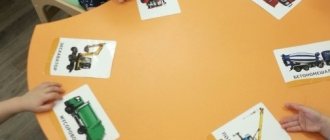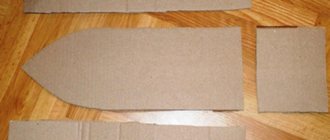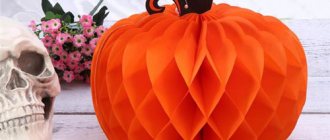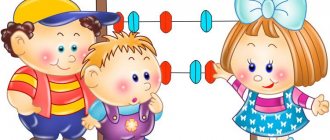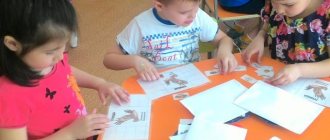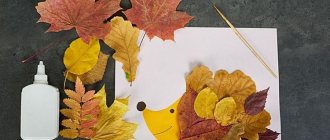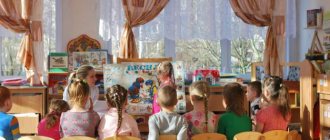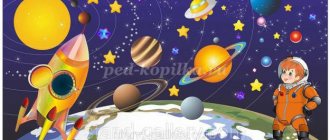Summary of a lesson on designing from natural materials in kindergarten. Senior group
Summary of GCD for the senior group on designing from natural material “Goldfish”
Description of the material: I offer you a summary of GCD for children of the senior group on designing from natural material “Goldfish” Purpose: to make crafts from natural material; enriching knowledge about the variety of natural materials and its use in crafts. Objectives: 1. To consolidate the idea of aquarium fish. 2. Foster an aesthetic attitude towards nature. 3. Continue to introduce children to the properties of natural materials. 4. Enrich children's vocabulary with verbs, nouns, adjectives and develop children's imagination. 6. Compose variants of images (fish)
from several parts 7. Develop children’s abilities in team work.
Visual material: Illustrations of an aquarium with fish. Handouts: shells, corrugated paper, plasticine, scissors, confetti.
Progress of the lesson
Children stand in a semicircle on the carpet.
Educator: Listen (the sound of the sea sounds)
.
Let's imagine that we are on the seashore. We have a blue sky above our heads, a bright sun shining, golden sand under our feet, and the sea ahead. Now I will tell you an interesting story. A wide variety of fish live in the sea. There are fish that are edible for humans. Fishermen catch them, and we buy them, cook them and eat them. These are flounder, mackerel, herring. (I invite the children to look at the fish)
There are poisonous fish.
And there are aquarium fish, they live at home in an aquarium. We made an aquarium, but so far no one lives in it. And today we will make fish for our aquarium. What parts does a fish consist of? (children's answers)
.
All fish have a tail. He serves as their rudder. Fish also have fins. Why do you think fish need fins? (to swim)
.
Of course, fish have eyes. What are eyes for? (see)
.
The body of the fish is covered with plates - these are scales. Why does the fish need it? (defend)
.
Now we'll swim a little. Physical education minute. We are now sailing on the sea And frolicking in the open space (rowing forward)
Have fun catching up with the dolphin
(raise your arms - wave-like movements)
And now it’s time to dive Into the underwater world.
(squat down and head to the right and left) Educator: And now we will sit at the tables. Please note that on your table there are: shells, from two shells we will make the body of a fish, from a strip of corrugated paper we will make a tail, from confetti we will make eyes. Educator. Now I will show you how you can make a very beautiful fish (I show a fish from shells) (I show how a fish is made.)
We take two shells, this will be the body of the fish, and using plasticine we connect the two halves of the shell.
Then we take scissors and a strip of corrugated paper and use it as “grass”. We twist the cut strip and use plasticine to attach the tail of the fish. Glue the fish's eyes. Let's get started. Then the teacher attaches a fishing line to each fish and hangs the fish in our aquarium. Educator: Look what beautiful fish are in our aquarium, and now they will live in our group. (children look at the fish and share their impressions)
.
We recommend watching:
Summary of educational activities in the senior group “Journey to a Fairy Tale” Summary of a mathematics lesson for children of the senior orthopedic group Summary of educational and gaming activities in the senior group in the section of the “Childhood” program Synopsis of educational activities for the perception of music in the senior group of kindergarten
Similar articles:
Lesson in the senior group of kindergarten on the topic of February 23
Lesson notes for children of senior preschool age. Topic: Invisible air
Summary of organized educational activities for children of the senior group
Notes for mathematics classes in the senior group
Lesson summary on the topic “Reserve” in the senior group
Construction as a type of children's creativity
Definition 1
Construction is the process of constructing an object, bringing various parts, elements and objects into a certain relative position.
Construction is a type of children's activity during which the child constructs a specific object (according to a scheme, plan, spontaneously, etc.). Construction occurs by composing parts or elements (cubes, building material, natural material, waste material, etc.) in any order, depending on the type of construction.
Construction is of great importance in the development of a preschool child, in his mastery of various types of practical activities. By its nature, construction is a productive type of children's activity.
Are you an expert in this subject area? We invite you to become the author of the Directory Working Conditions
The main feature of design is that it is creative in nature, as it is aimed at obtaining a specific expected product. In addition, design is also defined as a special experimental research and search activity aimed at obtaining a total product consisting of individual elements. Also, a number of researchers consider design from a creative point of view.
In the design process, the child uses a variety of materials that have different characteristics (size, shape, tactile sensations, etc.). By constructing from various materials, the child learns to generalize, masters universal skills for constructing a single whole from a set of elements.
Definition 2
Creative design is a complex system of practical and mental actions aimed at solving a specific constructive problem.
Finished works on a similar topic
Course work Designing from natural materials as a means of developing children's creativity 410 ₽ Abstract Designing from natural materials as a means of developing children's creativity 240 ₽ Test work Designing from natural materials as a means of developing children's creativity 250 ₽
Receive completed work or specialist advice on your educational project Find out the cost
Creativity in construction consists in the fact that a child, while engaged in construction, carries out such processes as thinking and planning his upcoming activities, translating an incipient mental concept into a real creative product.
Note 1
Thus, children's creative construction has a comprehensive impact on the child's development. It promotes the formation of a variety of practical skills, as well as the development of speech, memory, thinking, imagination and fantasy of the child.
Owl
Objectives: To expand children's understanding of the use of non-traditional natural material - pine cones for making various crafts in combination with other traditional materials; promote the development of the desire to independently design crafts; use assessment of children's work as a teaching tool.
Material: Pine cones, colored paper: yellow, black, white, red or yellow gouache paint, black cardboard paper, a small piece of wool thread, a branch (for the stand).
Birds Objectives: Develop the ability to work on one creative task in a group or subgroup, but at the same time perform one specific task; develop the ability to observe and analyze visual demonstration material offered by the teacher; Based on analysis and observation, determine (outline) the order of the upcoming work; promote a sense of collectivism in children; develop a positive attitude towards each other and living nature.
Materials: Spruce and pine cones, feathers, colored paper, gouache paint, foam for wings, twigs, walnuts, plasticine.
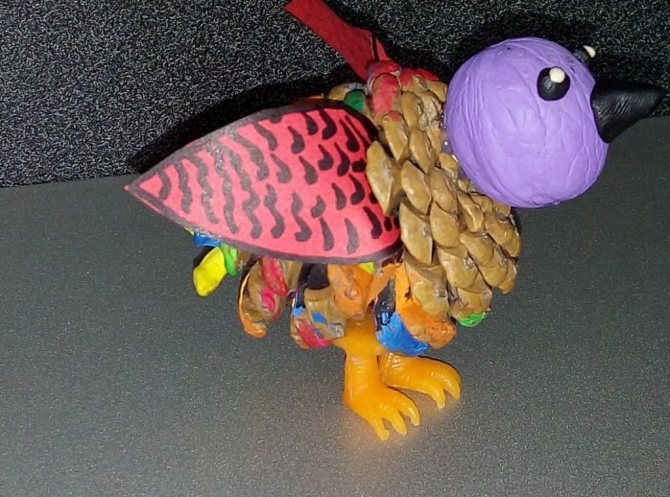
Baba Yaga
Objectives: Teach how to use natural materials to make crafts; develop fine motor skills of the hands; improve creativity; develop imagination, fantasy; to form compositional and aesthetic taste; promote the formation of curiosity and independence; cultivate perseverance, patience, accuracy in work; develop the ability to bring the work started to its logical conclusion;
to provide conditions for nurturing children's interest in arts and crafts and Russian folk tales.
Materials: Pine cones, pine needles, branches, coffee tin, twine, white and black paper, a small piece of fabric.

Topiary “Autumn”
Tasks:
Give an idea of the sequence of work on making topiary; teach the selection of materials for making an “autumn tree”; continue to develop skills in working with various natural and related materials:
to develop in children artistic taste, accuracy, precision, attention and creative exploration; develop hard work and mental activity; consolidate knowledge about the season - Autumn
Material: Pine cones, autumn tree leaves, rose hips, agrimony, flower pot.

Penguin
Objectives: To develop practical skills in working with a non-traditional material for construction - a pine cone. Learn to use natural materials in combination with other materials. To promote the development of mental analysis of the sequence of making crafts and the practical implementation of the task.
Material: Pine cones, colored paper - white, black, red, padding polyester, black gouache paint, polystyrene foam or cardboard (for the stand)

Snail
Objectives: Strengthen the skills and abilities of working with natural and waste materials; develop imagination and the desire to make a craft beautiful; promote the development of the desire to perform simple crafts consistently and accurately; create conditions conducive to the development of artistic, aesthetic taste, color perception; continue to learn how to plan your work and analyze the process.
Material: Pine cone, cardboard from a packaging box, gouache paints, woolen threads or ready-made pompoms.
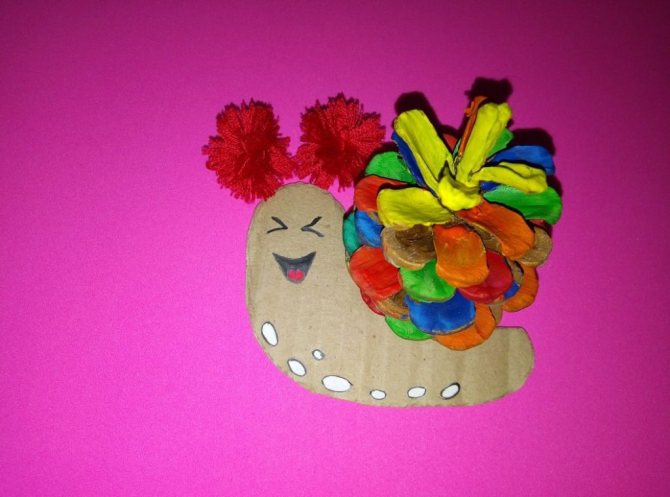
Swans
Goal: To promote the development of cooperation skills in children; promote the development of their desire to focus together on a single topic, while performing one specific task; improve skills in constructive and modeling activities using natural and related materials; continue to work on improving the ability to plan a sequence of actions when performing a creative task. Cultivate hard work and the ability to finish what you start.
Material: Pine cone, white gouache paint, plasticine: white, red, black, cardboard paper or board (stand).
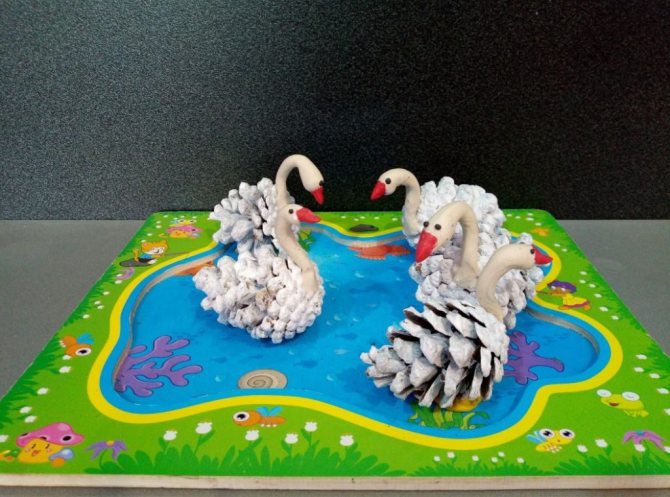
Preparation for work: Some natural materials require preliminary preparation, which parents do in advance, but you can involve children in this work, having previously explained to them what exactly needs to be done and how.
I hope that the presented material will be useful to you.
